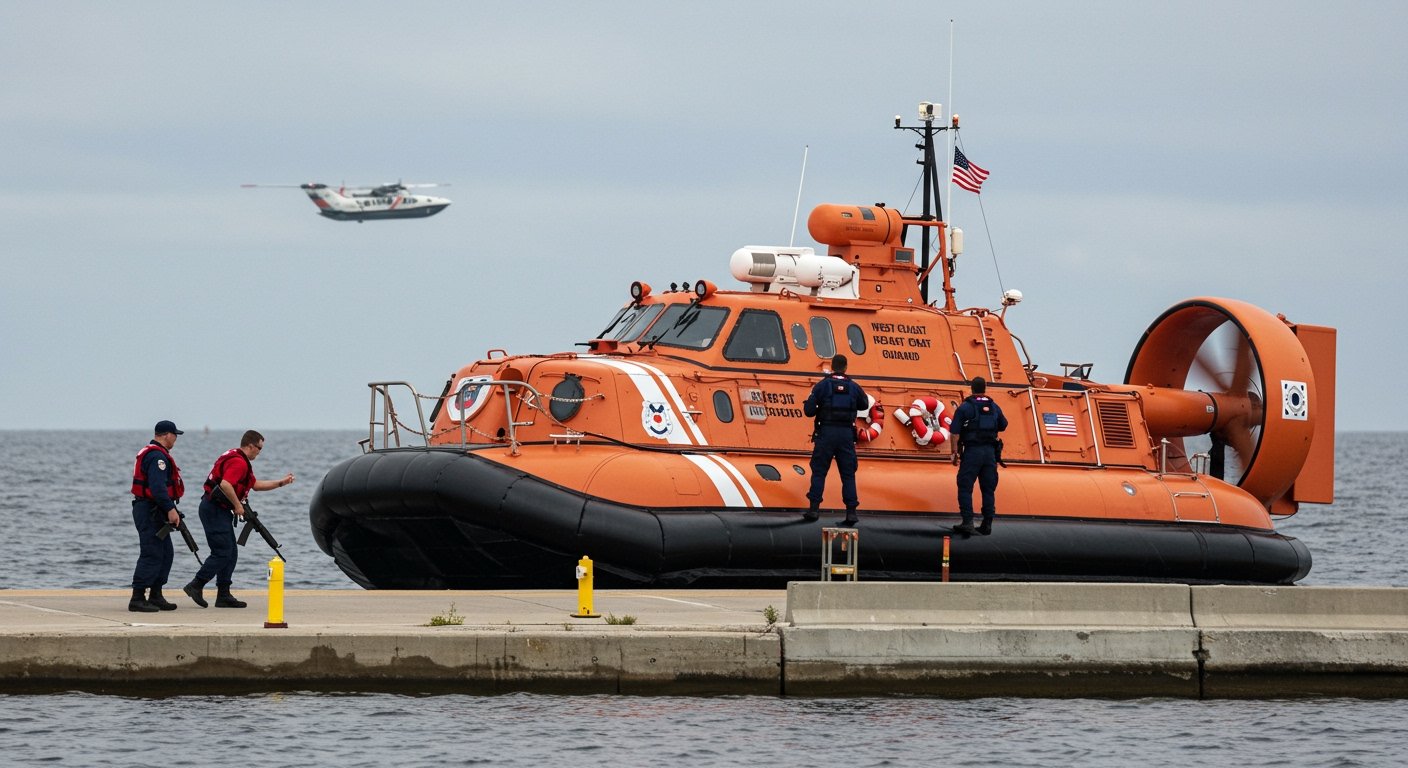West Coast Public Safety Impaired as Specialized Coast Guard Hovercraft Grounded
Washington, D.C. – A critical component of the United States Coast Guard’s operational capabilities on the West Coast has been temporarily sidelined. A pair of highly specialized vessels integral to maritime safety and security operations have been grounded. The reason cited for this operational pause is a significant lack of staff, impacting the Coast Guard’s ability to fully crew and operate these unique assets.
The vessels in question are Coast Guard hovercraft, known formally as Air Cushion Vehicles (ACVs). These unique platforms are specifically designed to operate over a variety of surfaces, including water, ice, snow, marshland, and mudflats. This capability makes them invaluable for missions in areas inaccessible to conventional boats or helicopters, particularly in the diverse and often challenging environments found on the West Coast.
Their grounding represents more than just a temporary reduction in available assets; it signals a potential gap in the service’s ability to serve public safety in specific critical scenarios requiring the hovercraft’s distinctive operational profile. The U.S. Coast Guard is tasked with a broad mandate that includes search and rescue, maritime law enforcement, environmental response, and ensuring the safety and navigability of waterways. The absence of these two specialized vessels could have implications for response times and effectiveness in certain operational areas within the West Coast region.
The Unique Capabilities of Coast Guard Hovercraft
Coast Guard hovercraft are highly specialized vessels primarily used in areas like San Francisco Bay, parts of the Pacific Northwest, and other shallow water or intertidal zones along the West Coast. Their ability to transition seamlessly between water and land makes them ideal for shallow water rescues, navigating dynamic estuary environments, and accessing shorelines where traditional boats would run aground. They can travel at high speeds, providing rapid response capabilities essential for emergencies.
These vessels are not merely transport platforms; they are equipped with sophisticated navigation systems, communication equipment, and are capable of carrying personnel and equipment necessary for various public safety missions. Their design allows them to operate independently of tide and depth, a crucial advantage in the variable conditions encountered on the West Coast.
The ‘specialized’ nature of these vessels also extends to the personnel required to operate and maintain them. Manning a hovercraft requires specific training and expertise, distinct from that needed for traditional surface vessels. Pilots, engineers, and crew members undergo rigorous training to safely and effectively operate these complex machines in challenging environments.
Staffing Shortages: The Root Cause
The decision to ground the pair of highly specialized vessels is directly attributed to a lack of staff. The U.S. military, including the Coast Guard, has faced recruitment and retention challenges in recent years, a factor that can be exacerbated in highly technical or specialized roles. The specific requirements for operating and maintaining hovercraft mean that staffing shortfalls in this particular area can have an immediate and significant impact on operational readiness.
A shortage of qualified personnel means that even if the vessels are mechanically sound, there may not be enough trained crew members available to operate them safely and effectively around the clock. This can lead to reduced operational hours, inability to deploy for certain missions, or, as in this case, the complete grounding of assets.
The lack of staff is a complex issue potentially stemming from a combination of factors, including competitive civilian job markets for skilled technicians, the demanding nature of military service, training pipeline constraints, and budget limitations that affect personnel numbers and training opportunities. Regardless of the underlying reasons, the consequence in this instance is the temporary loss of unique operational capability on the West Coast.
Impact on Public Safety Operations on the West Coast
The grounding of these Coast Guard hovercraft due to a lack of staff directly impacts the service’s capacity to serve public safety in the critical West Coast region. Potential ramifications include:
* Reduced Search and Rescue Capability: Hovercraft are often the preferred asset for search and rescue missions in shallow coastal waters, rivers, and bays where traditional boats cannot operate. Their absence could slow down response times or make rescue efforts in certain areas significantly more challenging.
* Limitations in Maritime Law Enforcement: Hovercraft can pursue vessels in shallow areas and are effective platforms for boarding and inspecting boats in complex waterways. Their grounding could impact law enforcement operations in these specific environments.
* Hindered Environmental Response: In cases of pollution or spills in coastal marshes or shallow areas, hovercraft allow responders to access and mitigate environmental damage without causing further harm to sensitive ecosystems. This capability is curtailed when the vessels are grounded.
* Support for Aids to Navigation: Hovercraft can provide logistical support for maintaining buoys and other aids to navigation located in shallow or intertidal zones. This essential function helps ensure the safety of maritime traffic.
While the Coast Guard possesses a diverse fleet of vessels, aircraft, and personnel, the highly specialized nature of the hovercraft means their capabilities are not easily replicated by other assets in all situations. Their grounding leaves a distinct gap in the operational toolkit available on the West Coast to serve public safety.
The Path Forward
The duration of the grounding related to the lack of staff remains unclear. Addressing personnel shortages, especially in specialized roles like hovercraft operations, typically requires sustained efforts in recruitment, training, and retention. Solutions can involve increasing recruitment incentives, streamlining training pipelines, or reallocating personnel, though such measures can take time to implement and yield results.
The grounding of the pair of highly specialized vessels underscores the challenges faced by military branches in maintaining readiness and capability when confronted with personnel shortfalls. For the West Coast, it means a temporary, but potentially significant, reduction in a unique asset vital for ensuring maritime safety and security. The situation highlights the critical link between adequate staffing and the effective delivery of essential public safety services by the U.S. Coast Guard.



















